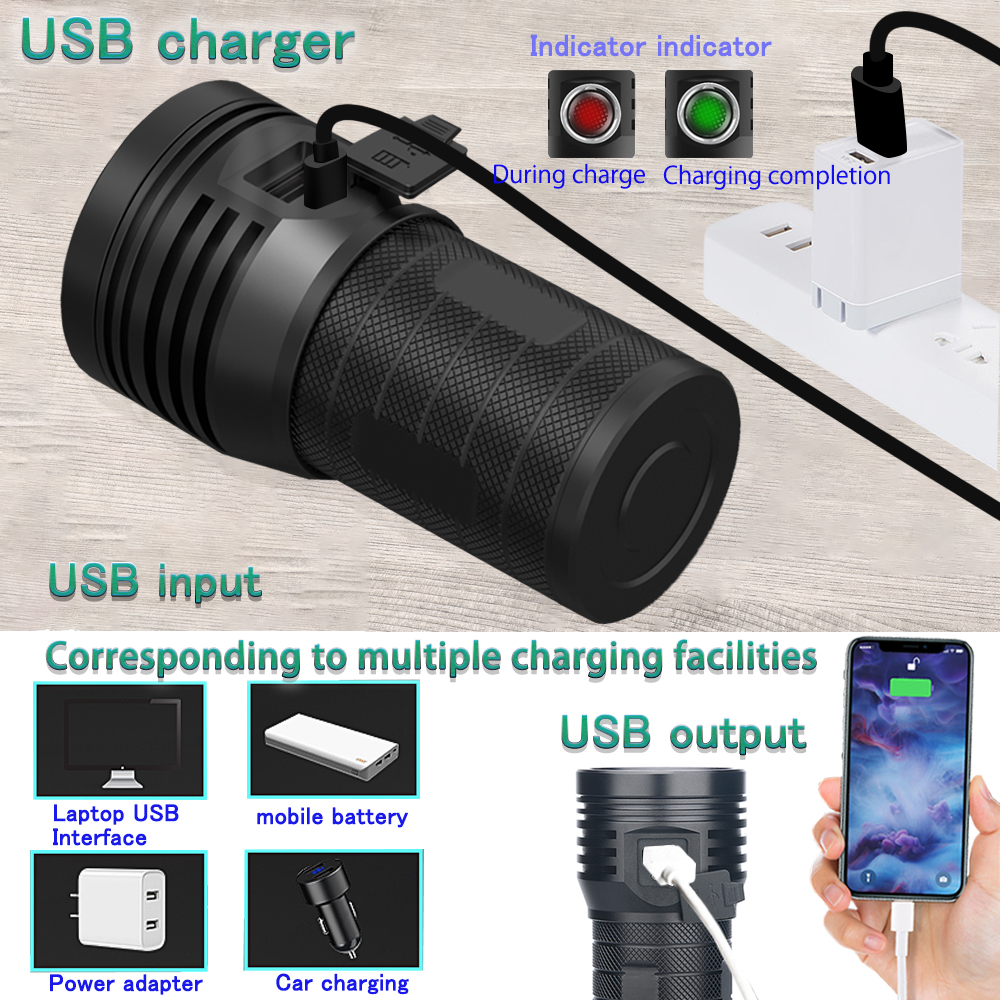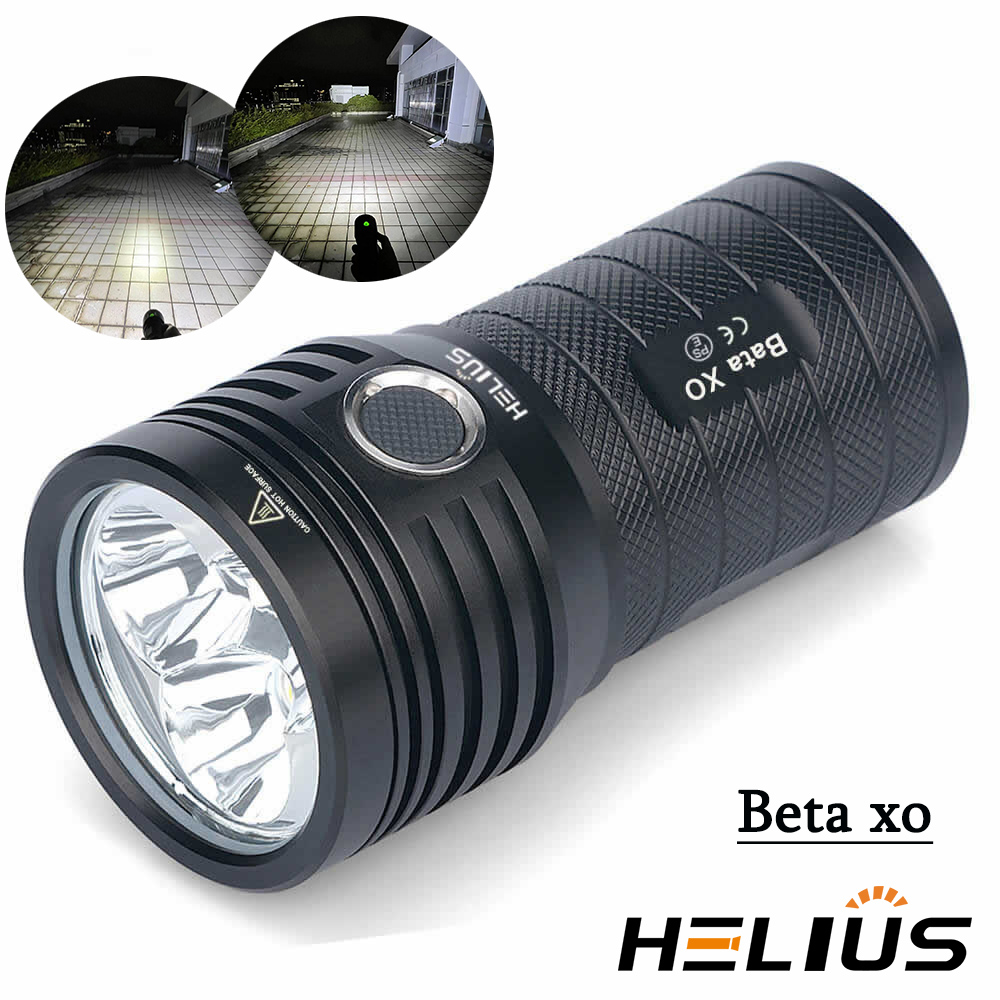Type-C rechargeable flashlights

Type-C rechargeable flashlights offer a modern solution for your lighting needs. Their advanced USB-C charging technology delivers up to 45 watts, far surpassing the 10 watts of older methods. This faster charging is ideal for high-capacity batteries, ensuring your flashlight is ready when you need it most. Whether you’re tackling small tasks, heading outdoors, or preparing for emergencies, these flashlights adapt to your lifestyle. Compact models fit easily in your pocket, while larger ones provide powerful illumination for work or hunting. Their compatibility with widely used USB-C ports makes them both convenient and future-proof.
Key Takeaways
Type-C rechargeable flashlights charge quickly, so they're ready faster.
Pick flashlights with 1,000 lumens or more for good brightness.
Get a flashlight with 3,000 mAh battery or higher for longer use.
Strong flashlights are important; choose ones that resist water and dust.
Think about size and weight for easy carrying, especially outdoors.
Best Type-C rechargeable flashlights

Best overall rechargeable flashlight
When choosing the best overall rechargeable flashlight, you should focus on key features that ensure reliability and performance. A flashlight with a battery capacity of around 3,000 mAh provides sufficient runtime for all-day use. Look for models offering multiple power modes. These settings allow you to conserve battery life during smaller tasks or switch to high output for emergencies. Brightness is another critical factor. A flashlight with at least 1,000 lumens ensures effective illumination in various situations. Additionally, an IP rating, such as IP68, guarantees resistance to dust and water, making the flashlight durable in challenging environments.
For example, a tactical flashlight with these features can serve as an excellent all-around option. It combines high brightness, long battery life, and rugged construction, making it suitable for both everyday use and outdoor adventures.
Best value rechargeable flashlight
Finding the best value rechargeable flashlight means balancing affordability with essential features. A flashlight with a battery capacity of 3,000 mAh is ideal for daily use, while 5,000 mAh or more offers extended runtime. Multiple power modes help you adjust brightness levels to match your needs, saving energy during less demanding tasks. Brightness of at least 1,000 lumens ensures clear visibility, and a high IP rating, such as IP68, protects against dust and water.
Feature | Description |
|---|---|
Battery Capacity | 3,000 mAh for daily use; 5,000 mAh or more for extended runtime. |
Power Modes | Adjustable settings for energy efficiency and versatility. |
IP Rating | High ratings (e.g., IP68) ensure durability against dust and water. |
Brightness | A minimum of 1,000 lumens for effective illumination. |
This combination of features ensures you get the most value for your money without compromising on quality or performance.
Best rechargeable flashlight for emergencies
In emergencies, you need a flashlight that delivers durability, long battery life, and exceptional brightness. High-quality materials ensure the flashlight withstands impacts and harsh conditions. A long-lasting battery provides continuous illumination, while adjustable brightness levels help you adapt to different scenarios. Multi-use functionality adds versatility, allowing the flashlight to serve various purposes beyond emergencies.
Feature | Description |
|---|---|
Durability | High-quality materials resist impacts and harsh environments. |
Battery Life | Long-lasting batteries ensure continuous illumination. |
Brightness Levels | Adjustable settings provide visibility in different situations. |
Multi-Use Functionality | Versatile design makes it suitable for various applications. |
These features make the best rechargeable flashlights for emergencies indispensable tools for your safety and preparedness.
Best rechargeable flashlight for outdoor adventures
When you venture into the great outdoors, having the right rechargeable flashlight can make all the difference. Lightweight and compact designs are essential for portability, allowing you to carry your flashlight with ease during hikes or camping trips. You won’t feel weighed down by heavy equipment, which is crucial for long treks. A flashlight with a rechargeable battery ensures consistent power over multiple uses, so you won’t have to worry about it failing during extended adventures. This reliability is vital when you’re far from charging stations or backup power sources.
Durability is another critical factor. Outdoor environments can be unpredictable, so your flashlight must withstand harsh conditions. Look for models made from high-strength materials like aluminum or toughened glass. These materials resist impacts and protect the flashlight from damage. Brightness is equally important. A flashlight with at least 1,000 lumens provides sufficient illumination for navigating dark trails or setting up camp after sunset. Additionally, choosing a model with an IP68 rating ensures protection against water and dust, making it suitable for rugged terrains.
Eco-conscious adventurers will appreciate the sustainability of rechargeable flashlights. By eliminating disposable batteries, you reduce environmental waste while enjoying a reliable lighting solution. Whether you’re hiking, camping, or preparing for emergencies, selecting a flashlight that balances portability, durability, and brightness will enhance your outdoor experience.
Best compact rechargeable flashlight for EDC
For everyday carry (EDC), a compact rechargeable flashlight offers unmatched convenience. Its small size allows you to slip it into your pocket or purse effortlessly. Despite its compact design, these flashlights deliver impressive brightness, with LED bulbs providing outputs ranging from 20 to 2,000 lumens. This versatility ensures you have the right amount of light for any situation, whether you’re searching for items in a dark space or walking home at night.
Long battery life is another key attribute. Flashlights compatible with lithium or lithium-ion rechargeable batteries offer extended usage, so you won’t need to recharge frequently. High IP ratings, such as IP66 or higher, protect these flashlights from water and dust, ensuring they remain functional in various environments. Impact resistance is also crucial. Models made from high-strength aluminum and toughened glass can withstand accidental drops, making them reliable for daily use.
When choosing the best flashlights for EDC, prioritize portability and durability. A flashlight that combines these features with efficient charging and long-lasting performance will serve you well in your daily activities. Compact rechargeable flashlights are not just practical; they’re an essential tool for anyone seeking convenience and reliability.
Key factors to consider when choosing a rechargeable flashlight
Battery capacity and runtime
When selecting a rechargeable flashlight, battery capacity plays a crucial role in determining how long it will last. Measured in milliamp hours (mAh), this figure indicates the amount of power the rechargeable battery can store. Flashlights with a capacity of around 3,000 mAh are ideal for providing long battery life during daily use. If you need extended runtime, consider models with 5,000 mAh or more. These can sustain powerful light for days, making them perfect for outdoor adventures or emergencies.
To maximize runtime, look for flashlights with energy-efficient modes. These allow you to adjust brightness levels, conserving power when full illumination isn’t necessary. A flashlight with a reliable rechargeable battery ensures you won’t be left in the dark when you need it most.
Brightness and lumens
Brightness is another critical factor to evaluate. Lumens measure the total amount of light emitted by a flashlight. Higher lumens generally mean brighter light, but you should also consider beam intensity and range. For example, a flashlight with 500+ lumens offers ultra-high output, suitable for outdoor or tactical use. Mid-range flashlights, with 250-500 lumens, work well for general tasks.
Lumens Range | Description |
|---|---|
500+ lumens | Ultra-high output for outdoor or tactical use. |
250-500 lumens | High output for general tasks. |
80-250 lumens | Mid-range output for everyday use. |
20-80 lumens | General-purpose light for basic needs. |
Keep in mind that a flashlight with more lumens doesn’t always throw light farther. Beam intensity, measured in candela, also affects performance. Choose a flashlight that balances lumens and beam intensity for your specific needs.
Durability and build quality
Durability ensures your flashlight performs reliably in tough conditions. Tactical rechargeable flashlights often feature rugged construction and high lumen output, making them dependable tools. Materials like aluminum or toughened glass enhance impact resistance. Outdoor models are designed to withstand harsh environments, offering water and dust resistance.
Rechargeable LED flashlights commonly use lithium-ion batteries. These batteries are lightweight and have a high energy density, contributing to portability. A durable flashlight with a long battery life and USB-C charging capability ensures you’re prepared for any situation.
Charging speed and efficiency
Charging speed is a critical factor when selecting a rechargeable flashlight. USB-C charging technology significantly improves efficiency by delivering faster power transfer compared to older micro-USB ports. This means you can fully charge your flashlight in less time, ensuring it’s ready when you need it. For instance, a flashlight with USB-C charging can often recharge in under three hours, depending on the battery capacity. This feature is especially useful during emergencies or outdoor trips where time is limited.
Efficiency also depends on the rechargeable battery type. Lithium-ion batteries, commonly used in rechargeable flashlights, offer high energy density and quick charging capabilities. Some models even include indicators to show charging progress, helping you monitor the process. By choosing a flashlight with USB-C charging and a reliable rechargeable battery, you ensure both speed and convenience.
Portability and size
Portability plays a vital role in how practical a rechargeable flashlight is for daily use. Lightweight designs and compact sizes make it easier to carry your flashlight wherever you go. For example, keychain flashlights are small enough to fit in your pocket, making them ideal for everyday tasks. Larger models, while less portable, provide higher brightness and longer runtime, making them better suited for outdoor adventures or work-related activities.
The size of a flashlight often depends on its intended use. A compact flashlight with a rechargeable battery is perfect for quick tasks or emergencies. On the other hand, a larger flashlight with a long battery life is more suitable for extended use. When choosing a flashlight, consider how and where you plan to use it to find the right balance between size and performance.
Additional features (e.g., waterproofing, strobe modes)
Additional features can greatly enhance the functionality of a rechargeable flashlight. Many models include multiple lighting modes, such as low, high, strobe, and SOS. These modes allow you to adapt to different situations, whether you need to conserve battery power or signal for help. Strobe modes and emergency signals are particularly useful for drawing attention during critical moments.
Waterproofing is another valuable feature. Flashlights with high IP ratings, such as IP68, can withstand water exposure, making them reliable in rainy or wet conditions. Impact resistance adds another layer of durability, ensuring your flashlight remains functional even after accidental drops. By selecting a flashlight with these features, you gain a versatile tool that performs well in various environments.
Comparison chart of the best rechargeable flashlights
Overview of specifications
When choosing a rechargeable flashlight, understanding the key specifications can help you make an informed decision. Here's a table that outlines the essential specifications to consider:
Specification | Description |
|---|---|
Candela | Measures beam intensity; indicates how focused the light is. |
Run Time | Duration of operation before recharging; varies with brightness settings. |
Rechargeable or disposable; affects weight, cost, and environmental impact. | |
Water Resistance | IP rating indicates protection against dust and water; crucial for outdoor activities. |
Durability | Material and build quality; drop test ratings indicate impact resistance. |
Modes and Features | Includes various light modes and additional features like zoom and SOS signals. |
These specifications provide a comprehensive view of what to expect from a flashlight, ensuring you select one that meets your needs.
Side-by-side comparison of features
To further assist you in selecting the right flashlight, here's a side-by-side comparison of features:
Feature | Description |
|---|---|
Battery Capacity | Measured in mAh; 3,000 mAh is ideal for all-day use, while 5,000 mAh or more offers extended use. |
Power Modes | Different settings (low, eco, high) affect battery life and usability for various tasks. |
IP Rating | Indicates dust and water resistance; IP68 is the highest rating for durability. |
Brightness | Measured in lumens; a minimum of 1,000 lumens is recommended for effective illumination. |
Brightness Modes | Includes high, low, medium, and additional modes like strobe and SOS for emergencies. |
Beam Distance | Ranges from 100 to over 700 meters; suitable for various uses like household or camping. |
Additional Features | USB ports for charging and waterproof ratings for outdoor use. |
This comparison highlights the diverse features available in rechargeable flashlights, helping you choose one that aligns with your specific requirements. Whether you need a flashlight for daily tasks or outdoor adventures, understanding these features will guide you in making the best choice.
Benefits of Type-C charging technology

Faster charging times
Type-C charging technology significantly reduces the time you spend waiting for your devices to recharge. This is possible because USB-C supports the Power Delivery (PD) standard, which allows for higher power output. The connector’s 24 pins carry power and data simultaneously, enabling faster voltage and current delivery compared to older charging methods.
Here’s why USB-C charging is faster:
It supports higher voltage levels, such as 5V, 9V, and even 20V, delivering more power in less time.
The connector engages in a process called "handshaking," where it communicates with your device to optimize power requirements.
Higher current output ensures a steady power supply, preventing voltage drops and improving efficiency.
With these advancements, usb-c charging ensures your flashlight or other devices are ready to use in a fraction of the time.
Reversible and user-friendly design
The reversible design of USB-C connectors makes them incredibly easy to use. You no longer need to worry about inserting the cable the wrong way. This smart design eliminates the frustration caused by traditional single-orientation connectors.
The user-friendly nature of USB-C enhances your experience. Whether you’re charging a flashlight in the dark or connecting a device in a hurry, the reversible connector ensures a seamless process. This feature saves time and reduces wear on both the cable and the port, making it a practical choice for everyday use.
Compatibility with modern devices
USB-C charging technology works with a wide range of modern devices, simplifying your charging needs. Many smartphones, including the iPhone 15 and leading Android models like Samsung Galaxy and Google Pixel, now use USB-C. Laptops, gaming consoles, and even wireless earbuds with advanced features like active noise cancellation also rely on this standard.
This compatibility streamlines your charging experience. You can use a single cable for multiple devices, reducing clutter and making your life more convenient. As more manufacturers adopt USB-C, it’s becoming the universal standard for charging and data transfer.
Future-proofing your gear
Future-proofing your gear means choosing technology that remains relevant as devices evolve. USB-C charging technology plays a key role in achieving this. Its growing adoption across smartphones, tablets, laptops, and accessories ensures you can use one cable for multiple devices. This universal compatibility simplifies your setup and extends the usability of your electronic gear.
USB-C also supports smart charging technology. This feature optimizes power transfer, allowing your devices to charge faster while generating less heat. High-performance devices, such as gaming laptops or advanced smartphones, benefit from this safe and efficient charging. You can rely on USB-C to keep your gear powered up without compromising battery health.
The shift to USB-C is not just a trend; it is part of a global effort to reduce e-waste. Many governments now promote a one-cord-fits-all approach to minimize the need for multiple chargers and adapters. By choosing USB-C-compatible flashlights and other devices, you contribute to a more sustainable future. You also save money by avoiding the constant purchase of new cables or dongles.
Tip: Investing in USB-C-compatible gear today ensures you stay ahead of technological changes. You won’t need to replace your devices or accessories as USB-C becomes the standard.
USB-C’s versatility and efficiency make it a smart choice for future-proofing. Whether you need a flashlight for emergencies or a laptop for work, USB-C ensures your gear remains functional and adaptable for years to come. By embracing this technology, you prepare yourself for a seamless and sustainable tech experience.
Type-C rechargeable flashlights offer unmatched efficiency, convenience, and versatility. You can charge them with any USB-compatible power source, saving money and reducing battery waste. Their durable design ensures long-lasting performance, making them ideal for emergencies, outdoor adventures, or daily use. For instance, models like the Fenix WF26R stay ready with features like charging cradles, ensuring reliability when you need it most.
When selecting a flashlight, think about your specific needs. Consider factors like size, battery type, and charging port compatibility. Exploring the recommended options helps you find a flashlight that fits your lifestyle while benefiting from the widespread availability of USB-C charging cables.
FAQ
What makes Type-C rechargeable flashlights better than traditional ones?
Type-C flashlights charge faster and offer universal compatibility with modern devices. Their reversible connector design makes them easier to use. They also support higher power delivery, ensuring efficient charging for high-capacity batteries.
Can I use any USB-C cable to charge my flashlight?
Yes, most USB-C rechargeable flashlights work with standard USB-C cables. However, using a high-quality cable ensures faster charging and better durability. Always check the flashlight’s specifications for compatibility.
How long does it take to fully charge a Type-C flashlight?
Charging time depends on the battery capacity and charger output. Most Type-C flashlights recharge within 2-4 hours. Models with larger batteries may take longer, especially if you use a lower-output charger.
Are Type-C rechargeable flashlights waterproof?
Many Type-C flashlights come with waterproof ratings like IP68. This ensures protection against water and dust. Always check the product’s IP rating to confirm its suitability for wet or outdoor conditions.
Do Type-C rechargeable flashlights support power banks?
Yes, most Type-C flashlights can charge via power banks. This makes them convenient for outdoor adventures or emergencies when wall outlets are unavailable. Ensure your power bank provides sufficient output for efficient charging.
See Also
How to Select the Perfect Rechargeable Flashlight for Hiking
A Guide to Rechargeable Flashlight Discharge Explained
Unveiling the Cyansky P50R: An Ultra Bright Flashlight
